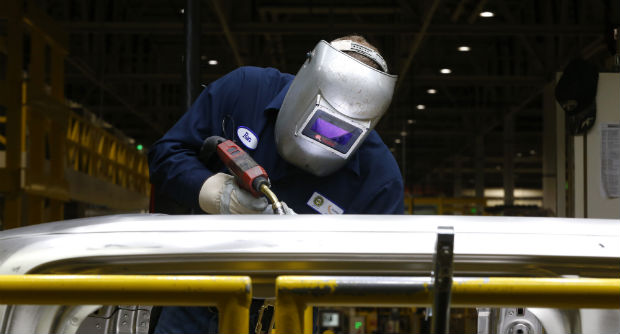US factory growth healthy despite slip

In this Nov. 11, 2014 photo, Ron Hudgins welds a 2015 Ford F-150 cab at the Dearborn Truck Plant in Dearborn, Mich. U.S. factories were slightly less busy in November, as production and hiring slowed, though the level of activity remained strong. AP
WASHINGTON — U.S. factories were slightly less busy in November, as production and hiring slowed, though the level of activity remained strong.
The Institute for Supply Management, a trade group of purchasing managers, said Monday that its manufacturing index slipped to 58.7 last month from 59 in October. Any reading above 50 signals expansion. October’s figure matched a three-year high reached in August.
Manufacturing has been a key driver of growth this year in the U.S., even as it has fallen off overseas. Factories in China, the world’s second-largest economy, are barely growing, according to a survey released Sunday by the bank HSBC Corp. And a European manufacturing index fell to 50.1 in November, the lowest in 17 months and just barely in expansion territory. Brazil’s manufacturing sector has contracted for the seventh time in eight months.
That has raised concerns among some economists that faltering overseas economies could soon drag on the U.S.
“While the U.S. economy is domestically-oriented, a rising dollar in combination with struggling global activity will weigh on economic growth over the next year,” Ksenia Bushmeneva, an economist at TD Economics, wrote in a note to clients. A stronger dollar makes U.S. goods more expensive overseas.
In the U.S., other manufacturing data has pointed to a recent slowdown in output, and many economists said Monday that factories are probably not growing as fast as the ISM’s survey suggests. The index has topped 56 since June, up from an average of just 53.9 last year.
“Although we remain optimistic about the outlook….we’re not convinced that conditions are quite as good as the ISM implies,” Paul Dales, senior economist at Capital Economics, said in a note to clients.
A measure of new U.S. orders rose and order backlogs jumped, both signs that output will likely remain solid in the coming months. A gauge of hiring dipped, but still pointed to steady job gains among manufacturing firms.
Lower oil prices are providing a big boost, the ISM found. Its measure of prices paid for raw materials plummeted to 44.5, the lowest in two years. Cheaper oil benefits plastic manufacturers, who use oil as an ingredient, and steelmakers and other manufacturers who use it for heating and shipping.
Other recent manufacturing reports have been mixed. Businesses ordered fewer big-ticket manufactured goods in October, excluding the volatile aircraft category, the government said last week. Orders in a key category reflecting business investment plans fell for the second straight month.
That’s raised concerns that economic growth could slow in the final three months of this year. The economy expanded at a 4.25 percent annual rate in the April-June and July-September quarters. That was the best six months of growth for the U.S. economy since 2003.
But there have been recent signs that growth is slowing. Consumer spending rose only modestly in October. Many economists now forecast growth will slide to a 2.5 percent rate in the current October-December quarter.
Hiring has been healthy this year, helping propel the economy. Employers had added an average of 229,000 jobs a month this year, up from 194,000 in 2013. That has helped lower the unemployment rate to 5.8 percent, a six-year low, down from 7.2 percent 12 months ago.
But the additional jobs have yet to spur meaningful wage growth.
Copyright 2014 The Associated Press. All rights reserved. This material may not be published, broadcast, rewritten or redistributed.
RELATED STORIES
AP survey: China slowdown to bruise global economy